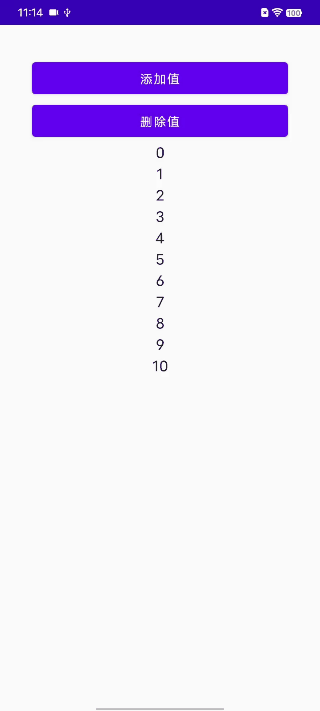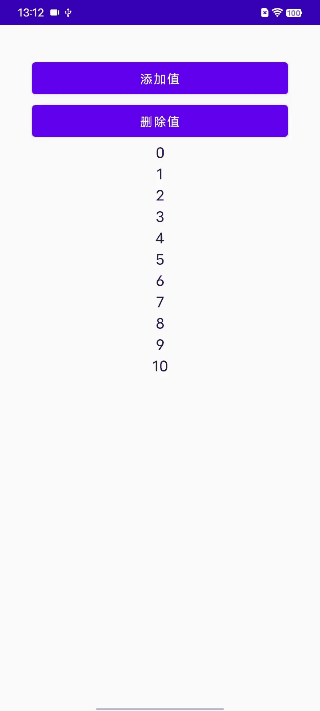您好,登錄后才能下訂單哦!
您好,登錄后才能下訂單哦!
本篇內容介紹了“Android Compose Column列表不自動刷新問題如何解決”的有關知識,在實際案例的操作過程中,不少人都會遇到這樣的困境,接下來就讓小編帶領大家學習一下如何處理這些情況吧!希望大家仔細閱讀,能夠學有所成!
我們都知道,Compose可以使用mutableStateOf和UI進行綁定,改變值之后,就可以改變UI。
var value by remember { mutableStateOf(0) }
var imageVisible by remember { mutableStateOf(true) }
Column {
Text(text = "現在的值是:$value")
Button(onClick = {
value++ //修改值,自動改變UI
}) {
Text(text = "Add Value")
}
AnimatedVisibility(visible = imageVisible) {
Image(
painter = painterResource(id = R.mipmap.photot1),
contentDescription = "",
Modifier.width(260.dp)
)
}
Button(onClick = {
imageVisible = !imageVisible //修改值,自動顯示/隱藏UI
}) {
Text(text = "Show/Hide")
}
}效果如下

但是如果是使用Column/Row/LazyColumn/LazyRow列表的時候,無論怎么更新數據,界面都不會刷新
val list = ArrayList<String>()
for (i in 0..10) {
list.add(i.toString())
}
var stateList by remember { mutableStateOf(list) }
Button(onClick = {
stateList.add("添加的值:${Random.nextInt()}")
}, modifier = Modifier.fillMaxWidth()) {
Text(text = "添加值")
}
Button(onClick = {
stateList.removeAt(stateList.size - 1)
}, modifier = Modifier.fillMaxWidth()) {
Text(text = "刪除值")
}
LazyColumn {
items(stateList.size) { index ->
Text(
text = "${stateList.get(index)}",
textAlign = TextAlign.Center,
modifier = Modifier
.height(24.dp)
.fillMaxWidth()
)
}
}可以看到,點擊了按鈕后,列表完全沒有刷新

這是為什么了 ?
當時很不解,為啥其他類型都是可以的,使用List就不行了呢 ?
查閱了好久,終于找到了解決方案
把mutableStateOf改用mutableStateListOf就可以了
var stateList = remember { mutableStateListOf<String>() }
for (i in 0..10) {
stateList.add(i.toString())
}
Button(onClick = {
stateList.add("添加的值:${Random.nextInt()}")
}, modifier = Modifier.fillMaxWidth()) {
Text(text = "添加值")
}
Button(onClick = {
stateList.removeAt(stateList.size - 1)
}, modifier = Modifier.fillMaxWidth()) {
Text(text = "刪除值")
}
LazyColumn {
items(stateList.size) { index ->
Text(
text = "${stateList.get(index)}",
textAlign = TextAlign.Center,
modifier = Modifier
.height(24.dp)
.fillMaxWidth()
)
}
}
解決方案很簡單,但是這是為什么呢 ?
3.1 mutableStateOf為什么可以更新UI
我們以mutableStateOf()這個為例
var value by mutableStateOf(0)
首先,我們要明白,mutableStateOf()返回的是一個MutableState對象,MutableState中有一個var value: T屬性
interface MutableState<T> : State<T> {
override var value: T
operator fun component1(): T
operator fun component2(): (T) -> Unit
}
interface State<out T> {
val value: T
}查看mutableStateOf源碼,可以發現,mutableStateOf()返回的是繼承自MutableState的SnapshotMutableState對象,路徑mutableStateOf()-> createSnapshotMutableState() -> ParcelableSnapshotMutableState-> SnapshotMutableStateImpl,可以看到有這樣一段代碼
override var value: T
get() = next.readable(this).value
set(value) = next.withCurrent {
if (!policy.equivalent(it.value, value)) {
next.overwritable(this, it) { this.value = value }
}
}
private var next: StateStateRecord<T> = StateStateRecord(value)這里就是重點,SnapshotMutableStateImpl的value屬性重寫了get()和set()方法
當value被讀的時候,不光把值返回,還會記錄一下在哪被讀的
當value被寫的時候,不止把這個值給改了,還會去查找在哪里被讀過,然后通知這些被讀過的地方,通知UI進行刷新
因為我們操作String、Int等基礎類型的時候,都是通過get、set()來獲取、設置數據的,所以這操作會被SnapshotMutableStateImpl記錄下來,而List、Map這種集合,我們是通過add、remove來更新數據的,所以不會觸發SnapshotMutableStateImpl value屬性的set。
使用mutableStateListOf替代mutableStateOf,mutableStateListOf內部對add、remove方法也進行了重寫
新創建一個List,然后賦值給原來的list,這樣就會觸發set了
var stateList by remember { mutableStateOf(list) }
val tempList = ArrayList<String>()
for (value in stateList) {
tempList.add(value)
}
tempList.add("添加的值:${Random.nextInt()}")
stateList = tempList //賦值的時候會觸發刷新UI我們也可以自己來實現一個mutableStateOf,偽代碼如下
class Test {
interface State<out T> {
val value: T
}
interface MutableState<T> : State<T> {
override var value: T
/*operator fun component1(): T
operator fun component2(): (T) -> Unit*/
}
inline operator fun <T> State<T>.getValue(thisObj: Any?, property: KProperty<*>): T = value
inline operator fun <T> MutableState<T>.setValue(
thisObj: Any?,
property: KProperty<*>,
value: T
) {
this.value = value
}
interface SnapshotMutableState<T> : MutableState<T> {
val policy: SnapshotMutationPolicy<T>
}
interface SnapshotMutationPolicy<T> {
fun equivalent(a: T, b: T): Boolean
fun merge(previous: T, current: T, applied: T): T? = null
}
internal open class SnapshotMutableStateImpl<T>(
val _value: T,
override val policy: SnapshotMutationPolicy<T>
) : /*StateObject, */SnapshotMutableState<T> {
private var next : T = 52 as T
@Suppress("UNCHECKED_CAST")
override var value: T
get() = next
/*get() {
Log.i(TAGs.TAG, "getValue:$field")
return "" as T
}*/
set(value) {
Log.i(TAGs.TAG, "setValue")
this.value = value
}
/*override fun component1(): T {
//TODO("Not yet implemented")
}
override fun component2(): (T) -> Unit {
//TODO("Not yet implemented")
}*/
}
internal class ParcelableSnapshotMutableState<T>(
value: T,
policy: SnapshotMutationPolicy<T>
) : SnapshotMutableStateImpl<T>(value, policy)/*, Parcelable*/ {
}
fun <T> mutableStateOf(
value: T,
policy: SnapshotMutationPolicy<T> = structuralEqualityPolicy()
): MutableState<T> = createSnapshotMutableState(value, policy)
fun <T> structuralEqualityPolicy(): SnapshotMutationPolicy<T> =
StructuralEqualityPolicy as SnapshotMutationPolicy<T>
private object StructuralEqualityPolicy : SnapshotMutationPolicy<Any?> {
override fun equivalent(a: Any?, b: Any?) = a == b
override fun toString() = "StructuralEqualityPolicy"
}
fun <T> createSnapshotMutableState(
value: T,
policy: SnapshotMutationPolicy<T>
): SnapshotMutableState<T> = ParcelableSnapshotMutableState(value, policy)
fun main() {
var sizeUpdate by mutableStateOf(48)
Log.i(TAGs.TAG, "sizeUpdate:$sizeUpdate")
sizeUpdate = 64
Log.i(TAGs.TAG, "sizeUpdate>>$sizeUpdate")
}
}“Android Compose Column列表不自動刷新問題如何解決”的內容就介紹到這里了,感謝大家的閱讀。如果想了解更多行業相關的知識可以關注億速云網站,小編將為大家輸出更多高質量的實用文章!
免責聲明:本站發布的內容(圖片、視頻和文字)以原創、轉載和分享為主,文章觀點不代表本網站立場,如果涉及侵權請聯系站長郵箱:is@yisu.com進行舉報,并提供相關證據,一經查實,將立刻刪除涉嫌侵權內容。